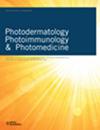白癜风的光疗:临床和分子方面的叙述性综述以及最新文献
IF 2.2
4区 医学
Q2 DERMATOLOGY
引用次数: 0
摘要
背景白癜风的特征是黑色素细胞脱失导致的色素脱失斑。光疗已成为治疗白癜风的一种重要方法,它利用各种光照模式诱导疾病稳定和再色素沉着。结果与讨论该综述评估了现有的白癜风光疗文献,分析了基于医院和家庭的光疗研究,以及与疾病稳定和再色素沉着相关的结果。窄带紫外线 B(即 NBUVB)仍然是白癜风光疗中最常用、最受研究、最有效的方法。本研究特别关注对不同类型的灯管、剂量测定、已发布的指南以及有针对性的光疗方法的使用进行评估。此外,还讨论了光疗与其他治疗方式的结合,包括将其用作泛发型/全身型白癜风的脱色疗法。结论综上所述,本综述全面概述了用于白癜风治疗的光疗。它强调了光疗不断发展的前景,并为优化治疗效果和应对未来挑战提供了见解。通过将临床证据与分子认识相结合,光疗已成为治疗白癜风的一种有价值的治疗方法,并有可能在该领域取得进一步的进展。本文章由计算机程序翻译,如有差异,请以英文原文为准。
Phototherapy for vitiligo: A narrative review on the clinical and molecular aspects, and recent literature
BackgroundVitiligo is characterized by depigmented patches resulting from loss of melanocytes. Phototherapy has emerged as a prominent treatment option for vitiligo, utilizing various light modalities to induce disease stability and repigmentation.Aims and MethodsThis narrative review aims to explore the clinical applications and molecular mechanisms of phototherapy in vitiligo.Results and DiscussionThe review evaluates existing literature on phototherapy for vitiligo, analyzing studies on hospital‐based and home‐based phototherapy, as well as outcomes related to stabilization and repigmentation. Narrowband ultra‐violet B, that is, NBUVB remains the most commonly employed, studied and effective phototherapy modality for vitiligo. Special attention is given to assessing different types of lamps, dosimetry, published guidelines, and the utilization of targeted phototherapy modalities. Additionally, the integration of phototherapy with other treatment modalities, including its use as a depigmenting therapy in generalized/universal vitiligo, is discussed. Screening for anti‐nuclear antibodies and tailoring approaches for non‐photo‐adapters are also examined.ConclusionIn conclusion, this review provides a comprehensive overview of phototherapy for vitiligo treatment. It underscores the evolving landscape of phototherapy and offers insights into optimizing therapeutic outcomes and addressing the challenges ahead. By integrating clinical evidence with molecular understanding, phototherapy emerges as a valuable therapeutic option for managing vitiligo, with potential for further advancements in the field.
求助全文
通过发布文献求助,成功后即可免费获取论文全文。
去求助
来源期刊
CiteScore
4.40
自引率
7.70%
发文量
85
审稿时长
6-12 weeks
期刊介绍:
The journal is a forum for new information about the direct and distant effects of electromagnetic radiation (ultraviolet, visible and infrared) mediated through skin. The divisions of the editorial board reflect areas of specific interest: aging, carcinogenesis, immunology, instrumentation and optics, lasers, photodynamic therapy, photosensitivity, pigmentation and therapy. Photodermatology, Photoimmunology & Photomedicine includes original articles, reviews, communications and editorials.
Original articles may include the investigation of experimental or pathological processes in humans or animals in vivo or the investigation of radiation effects in cells or tissues in vitro. Methodology need have no limitation; rather, it should be appropriate to the question addressed.

 求助内容:
求助内容: 应助结果提醒方式:
应助结果提醒方式:


